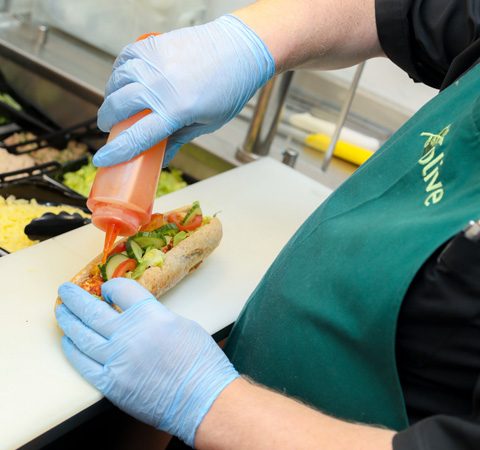For those working in the food manufacturing industry, there will always be a clear focus on delivering and maintaining the highest levels of health and safety. This is crucial for both employees and for consumers of the product, which is why PPE specification must be up-to-date, accurate and perfectly matched to the unique requirements of the application.
In this blog, we’re going to take a look at the key considerations when specifying PPE for the food processing sector, covering the key pieces of equipment for operatives.
Food handling
The most obvious danger in food processing is contamination, which can occur directly from body to food, or indirectly between different foods. This can result in harmful bacteria entering the product, and for any business in the food industry, contamination must be avoided at all costs given the reputational damage it can cause.
This is where work gloves play a key role. Disposable gloves are one of the primary means for minimising the risk of contamination, given that they are regularly removed and replaced by design. However, it can be all too easy to assume that because they are disposable, specification is a simple process that doesn’t require much thought. This is where it is important to understand the various options available.
There are a range of different materials that can be used for hand protection, and it is important to note that some hold certain advantages over others. The four main types are latex gloves, nitrile gloves, vinyl gloves, and the more recently developed ultra-nitrile gloves. Understanding why one might be preferable over the other is important in ensuring the highest levels of food hygiene.
Latex gloves are a popular choice owing to their fantastic fit, sensitivity, and versatility. Our
powder-free versions are complete with a beaded cuff, which helps to minimise the risk of contamination from the hand. In fact, across all versions of disposable gloves, powder free is an important feature for food manufacturing. It once again links with the need to reduce instances of contamination, and decreases the chance of residue entering the product.
Nitrile gloves, such as our versatile
powder free nitrile models, are useful for when a latex free material is required.
We have previously highlighted that up to 5% of the population has a latex allergy, which means an alternative can often be needed to ensure the comfort of employees.
Vinyl is another latex free glove option, and we’ve created a range with an array of colours for applications that require colour-coding. This can be especially useful from a food safety perspective, helping to distinguish between low and high risk products.
Finally,
ultra-nitrile gloves incorporate new technology to offer excellent strength, high dexterity, and supreme comfort for the wearer thanks to a lightweight finish. Our powder free versions are food approved and available in blue or clear colour options, marking them out as ideal for food manufacturing environments.
Footwear
Hand protection is crucial from a food hygiene perspective, and is largely there to protect consumers. But it is also important for those tasked with the specification of PPE to consider the health and safety of operators. As slips and trips are one of the largest causes of injuries to employees in the sector, footwear has a big role to play.
Safety wellington boots are a great choice for providing anti-slip protection in a food processing environment. Supertouch’s new
Food-X® PU Safety Wellington are lightweight SRC anti-slip options, which are both durable and comfortable for wearing over prolonged periods of time. They also feature cold insulating properties, keeping workers warm and dry even in cool conditions. Available in green and white, attention to detail in the design of these boots, such as kick off spurs to allow them to be taken off easily and hygienically, marks them out as ideal for protecting feet in food manufacturing facilities.
Disposable overshoes such as
these CPE versions, are a simple and effective solution for maintaining the safety and hygiene of employees. As with the gloves above, they can be colour coded to minimise the risk of cross-contamination, and the embossed finish provides grip to reduce the wearer’s chances of slips and falls.
Headwear
Just as disposable gloves are designed to combat contamination of product, it is also worth considering the utility of mob caps. Opting for one
with an elasticated headband will minimise the risk of hair follicles falling into food, and there are
versions that include a metallic strip for increased detectability. In the same way as much of the PPE we have covered throughout this blog, disposable mob caps, and particularly detectable mob caps, are designed to minimise contamination of product. They are also available in a range of colours to contribute further to food safety.
Disposable Aprons and Coveralls
With the extremities covered, it is also important to look at how the main part of the body of operators can be addressed. This will prevent risk of contaminants from clothing, and also serve as a barrier to stop the product from splashing onto employee clothes.
There are a
range of disposable aprons that can offer this type of barrier protection, with varying sizes and features to suit a number of different environments. For applications which require higher levels of sanitation and protection, it might be worth opting for a
disposable coverall.
Specifying right
As we’ve outlined in this blog, there are a lot of different factors to consider when it comes to specifying PPE for a food manufacturing environment. Disposable gloves are always going to be the most important piece of equipment, so getting those right is critical. Backing this up with the rest of the PPE outlined here will ensure food processing operators are suitably equipped to carry out their job.
Check out our full range of disposable PPE
here



